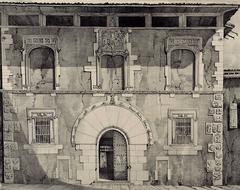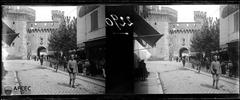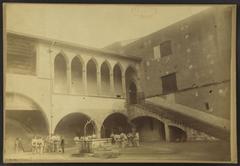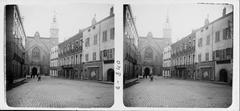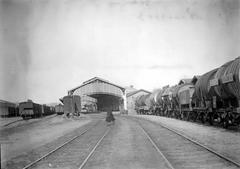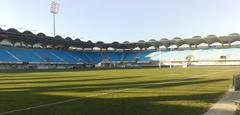
Palais de la Députation Perpignan: Visiting Hours, Tickets, and Comprehensive Guide
Date: 04/07/2025
Introduction
The Palais de la Députation stands at the heart of Perpignan’s historic center, embodying the city’s rich blend of Catalan and French heritage. Built in the 15th century as the seat of the Estates of Roussillon, this landmark has evolved from a medieval political hub to a vibrant civic and cultural venue. With its striking Gothic and early Renaissance architecture, ornate interiors, and deep historical roots, the palace offers a captivating journey through centuries of shifting sovereignties, artistic trends, and local traditions. This guide provides all the essential information—visiting hours, ticket details, accessibility, and travel tips—to ensure an enriching visit to one of Perpignan’s most significant historical sites.
Historical Overview
Medieval Foundations and Political Role
Constructed in the mid-15th century, the Palais de la Députation was originally designed to house the Deputation of the Estates of Roussillon, a representative assembly responsible for regional governance, taxation, and justice (Perpignan Méditerranée Tourisme). Its establishment marked a pivotal era in Perpignan’s history, reflecting the city’s transition from Aragonese to French control and its role as a crossroads between the Iberian and French worlds (Navaway). The palace’s location, adjacent to the Hôtel de Ville and Place de la Loge, underscores its central role in political and civic life.
Following the Treaty of the Pyrenees in 1659, which ceded Roussillon to France, the palace adapted to new functions—serving as a courthouse and later integrating into the Hôtel de Ville complex (Wikipedia). Throughout these transitions, it remained a focal point for civic authority and regional identity.
Symbol of Catalan Identity and Bicultural Heritage
For centuries, the palace was a powerful symbol of Catalan autonomy, especially during times of political upheaval and cultural negotiation. Even after annexation by France, it continued to represent local heritage and pride. In the modern era, it has become a venue for cultural events and exhibitions that celebrate Perpignan’s dual identity (The York Historian). The building’s ongoing use for public gatherings and its location in the vibrant Place de la Loge reinforce its role as a living institution.
Architectural Features and Artistic Highlights
Exterior Architecture
The palace exemplifies late Gothic architecture with distinctive trilobed windows, semi-circular arched doorways, and intricately carved capitals adorned with foliage motifs (luc.greliche.free.fr). The use of slender colonnettes and harmonious proportions reflects the Catalan Gothic tradition, distinguished by an emphasis on verticality and lightness (Wikipedia).
Interior Spaces
- Central Patio: A quintessential Mediterranean feature, the courtyard offers natural light and showcases “La Méditerranée,” the celebrated sculpture by Aristide Maillol (Perpignan Tourisme).
- Salle des Mariages (Former Salle des Consuls): The Hispano-Moorish ceiling—rich with geometric patterns and vibrant colors—illustrates the region’s cross-cultural artistic exchanges.
- Ceremonial Halls: Retaining 19th-century décor, these spaces offer insight into the lifestyles and ceremonies of Perpignan’s historical elite.
Artistic Heritage
The integration of Gothic, Renaissance, and Moorish elements, along with the presence of Maillol’s modern sculpture, demonstrates the palace’s ongoing engagement with artistic innovation across centuries (The Crazy Tourist).
Visitor Information
Location
- Address: Place de la Loge, Perpignan, France
- Setting: Central historic district, adjacent to Hôtel de Ville and Loge de Mer (Petit Futé)
Visiting Hours
-
Palace Interior and Patio:
Open Tuesday to Sunday, 10:00 AM – 6:00 PM; closed Mondays and public holidays.
(Last admission: 5:30 PM; hours may vary for special events—check Perpignan Méditerranée Tourisme for updates.) -
Courtyard Passage:
Open to the public during daylight hours, generally from 8:00 AM to sunset. No ticket or reservation necessary for courtyard access (SeeVisit).
Admission and Tickets
- General Admission: Free entry to the courtyard and principal halls.
- Special Exhibitions/Guided Tours: Some events or in-depth guided tours may require tickets (typically €5–€10). Book via the tourism office or online.
Accessibility
- Physical Access: Partial accessibility for visitors with reduced mobility (ramps available in the courtyard and select ground-floor rooms; some historic areas may have limited access).
- Facilities: No dedicated visitor center or restrooms on-site, but nearby squares offer cafés and amenities.
Photography
- Photography is permitted in the courtyard and exterior. Flash and tripods are generally prohibited inside.
Travel Tips
- Combine Your Visit: The palace is best enjoyed as part of a walking tour of Perpignan’s historic core. Combine with the Castillet, Hôtel de Ville, and Musée Hyacinthe-Rigaud for a comprehensive experience (Generation Voyage).
- Best Times: Visit early morning or late afternoon for optimal lighting and fewer crowds.
- Accessibility Note: Some uneven paving in the courtyard; visitors with mobility needs should proceed with care.
Nearby Attractions
- Hôtel de Ville: Adjacent historic city hall with notable architectural features.
- Loge de Mer: Former maritime exchange, rich in commercial history.
- Castillet: Iconic medieval gate and tower museum.
- Palais des Rois de Majorque: Grand royal palace open for tours (Petit Futé).
- Saint Jacques Church: A beautiful nearby Gothic church.
- Place de la Loge: Lively square for cafés and people-watching.
Events and Cultural Life
The Palais de la Députation regularly hosts exhibitions, public ceremonies, and cultural events that highlight Perpignan’s artistic and historical heritage (The Tourist Checklist). While there are no regular guided tours, special events and temporary exhibitions are advertised through local tourism channels.
Frequently Asked Questions (FAQ)
Q: What are the visiting hours?
A: Tuesday to Sunday, 10:00 AM – 6:00 PM; closed Mondays and public holidays.
Q: Is there an entry fee?
A: General access is free. Special exhibitions or guided tours may require a ticket.
Q: Is the site accessible to those with disabilities?
A: Partial accessibility; contact the visitor center for details.
Q: Are guided tours offered?
A: Yes, during special events. Book via the tourism office or on-site.
Q: Can I take photos?
A: Yes, in the courtyard and exterior. Restrictions apply inside.
Q: Is there parking nearby?
A: Limited parking near Place de la Loge; public transport and walking are recommended.
Visuals and Media
For images and a virtual tour, visit the official tourism site. Alt tags such as “Palais de la Députation Perpignan façade” and “Hispano-Moorish ceiling in Salle des Mariages” enhance accessibility.
Summary and Recommendations
The Palais de la Députation is more than a historic building—it’s a living testament to Perpignan’s enduring political, architectural, and cultural legacy. Its free admission, central location, and integration into the city’s vibrant life make it an essential stop for any visitor. Explore its Gothic details, reflect in its atmospheric courtyard, and appreciate its role as both a symbol and a stage for Perpignan’s ongoing story.
Sources and Further Reading
- Perpignan Méditerranée Tourisme
- Navaway
- The Crazy Tourist
- Made in Perpignan
- The York Historian
- Wikipedia
- Luc Greliche
- Petit Futé
- SeeVisit
For further travel planning, download the Audiala app for audio-guided tours and real-time updates on Perpignan’s historical sites. Follow local tourism channels for current events and exhibitions.





